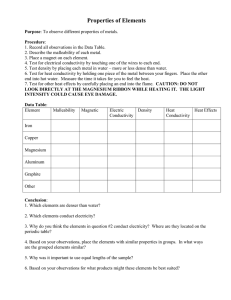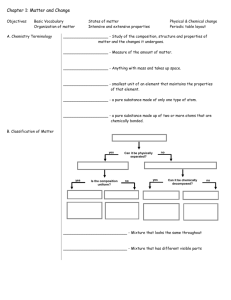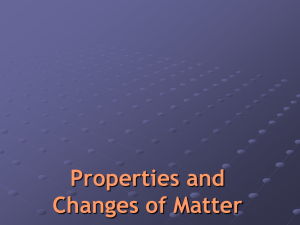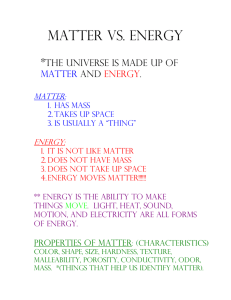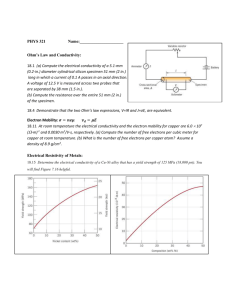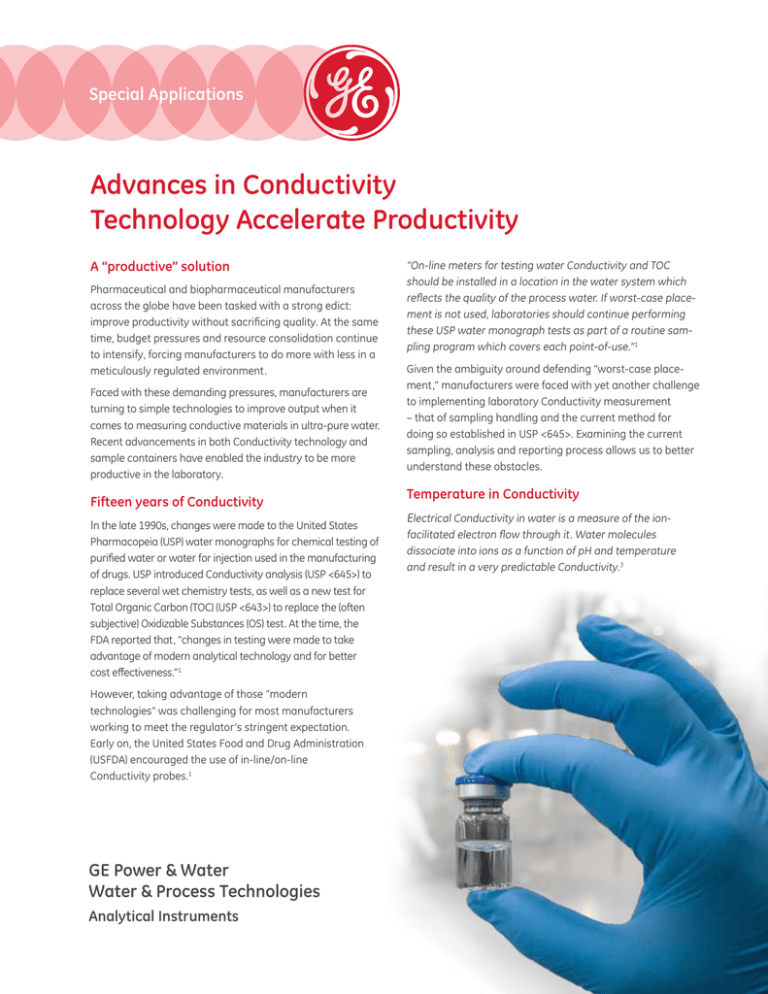
Special Applications
Advances in Conductivity
Technology Accelerate Productivity
A “productive” solution
Pharmaceutical and biopharmaceutical manufacturers
across the globe have been tasked with a strong edict:
improve productivity without sacrificing quality. At the same
time, budget pressures and resource consolidation continue
to intensify, forcing manufacturers to do more with less in a
meticulously regulated environment.
Faced with these demanding pressures, manufacturers are
turning to simple technologies to improve output when it
comes to measuring conductive materials in ultra-pure water.
Recent advancements in both Conductivity technology and
sample containers have enabled the industry to be more
productive in the laboratory.
Fifteen years of Conductivity
In the late 1990s, changes were made to the United States
Pharmacopeia (USP) water monographs for chemical testing of
purified water or water for injection used in the manufacturing
of drugs. USP introduced Conductivity analysis (USP <645>) to
replace several wet chemistry tests, as well as a new test for
Total Organic Carbon (TOC) (USP <643>) to replace the (often
subjective) Oxidizable Substances (OS) test. At the time, the
FDA reported that, “changes in testing were made to take
advantage of modern analytical technology and for better
cost effectiveness.”1
However, taking advantage of those “modern
technologies” was challenging for most manufacturers
working to meet the regulator’s stringent expectation.
Early on, the United States Food and Drug Administration
(USFDA) encouraged the use of in-line/on-line
conductivity probes.1
GE Power & Water
Water & Process Technologies
Analytical Instruments
“On-line meters for testing water conductivity and TOC
should be installed in a location in the water system which
reflects the quality of the process water. If worst-case placement is not used, laboratories should continue performing
these USP water monograph tests as part of a routine sampling program which covers each point-of-use.”1
Given the ambiguity around defending “worst-case placement,” manufacturers were faced with yet another challenge
to implementing laboratory conductivity measurement
– that of sampling handling and the current method for
doing so established in USP <645>. Examining the current
sampling, analysis and reporting process allows us to better
understand these obstacles.
Temperature in Conductivity
Electrical conductivity in water is a measure of the ionfacilitated electron flow through it. Water molecules
dissociate into ions as a function of pH and temperature
and result in a very predictable conductivity.3
Because temperature has a substantial impact on conductivity
readings of specimens at high and low temperatures, USP
<645> mandates a temperature measurement is required
for the performance of the Stage 1 testing. This temperature
reading can fluctuate in a water system; therefore it can be
hard to predict the level of conductive species present in the
water system or at every point-of-use.
That said, many companies revert to Stage 2 conductivity for
sampling analysis and reporting. This process is time consuming given USP <645> requires the following for EVERY sample:
Costly Conductivity is what most “expect”
GE Analytical Instruments surveyed manufacturers regarding
their laboratory water chemistry testing practices; more than
40% said their sample plans do not incorporate on-line conductivity sampling, analysis, and reporting. Many criticize the
regulation for rendering the process for conductivity analysis
time-consuming, costly, and confusing.
In other industries, manufacturers constantly fiddle with
production lines and sampling to find improvements. But for
most in the pharmaceutical industry, regulations leave drugmanufacturing processes and laboratory testing frozen
in time.2
Jun Bautista, Quality Director, Metrology for Genzyme, describes the situation from the manufacturer’s perspective,
“Conductivity can be costly when you have to sample every
point-of-use on the water system. The USP <645> test indicates three stages of testing. So if you are not capable of doing Stage 1 testing with on-line technologies or by controlling
the sampling process, then your cost of sampling, analysis,
and reporting go up five-fold with Stage 2 testing. These costs
should not be the expectation for manufacturers. We can do
better.”
Conductivity for cleaning
Often Conductivity measurement is utilized in cleaning applications to determine cleaning effectiveness and removal
of harsh inorganic chemicals that might be left over from
the cleaning process. A logical way to monitor and control a
cleaning process may include, on-line or in-line probes that
measure conductive cleaning agents.
Yet, manufacturers who are unable to incorporate on-line or
in-line conductivity probes revert back to time consuming and
non-productive approaches, or they adopt USP <645> Stage 2
testing. Stage 2 testing creates equipment downtime causing
a bigger bottleneck, which becomes more costly than water
samples. Production delays can cost manufacturers millions.
Essential reform
Conclusion
Recent reform promises relief for some of the challenges
manufacturers face when implementing Conductivity analysis.
More than fifteen years ago the FDA introduced Conductivity
measurement to their water analysis monographs,
acknowledging the potential benefits of using what they called
“modern analytical technology.” Still today, manufacturers
continue to struggle to find a cost-effective, efficient way to
take advantage of this measurement tool.
Pharmacopeia alignment
The Japan Pharmacopeia (JP16) understands that, “The measurement of conductivity for monitoring is usually conducted
continuously using an in-line or on-line apparatus with a flowthrough type or pipe-insertion type cell.”4 However, recognizing the difficulty in controlling the temperature with on-line or
in-line conductivity probes, the JP16 has harmonized with USP
<645> and the European Pharmacopeia (2.2.38) by “allowing
conductivity monitoring [of samples other than 20 °C] by applying the <645> WATER CONDUCTIVITY of the USP with some
modifications . . . based on Stages I and II of the three-stage
approach.”4
Conductivity analysis is a logical and essential tool for
pharmaceutical and biopharmaceutical manufacturers.
As regulatory bodies work to align their processes and
reform their edicts, technology advancement coupled with
educational support and community dialogue accelerate
productivity for manufacturers worldwide.
References:
1.Human Drug CGMP Notes: A Memo on Current Good Manufacturing Practice
Off-line Stage 1
On-line conductivity testing provides real-time measurements
and opportunities for real-time process control, decision, and
intervention.3 However, not all pharmaceutical manufacturers have the capability to incorporate this approach. Knowing
this, USP <645> specifies that off-line Stage 1 testing can be
achieved if a suitable container and the right technology are
used. Controlling temperature is no longer necessary, giving
manufacturers the opportunity to use simpler technologies to
become more productive.
A remarkable technology
Other processes require two separate technologies to measure
TOC and Conductivity. Using one sample vial, the Sievers M9
TOC Analyzers simultaneously analyze and report two discrete
results for TOC and Conductivity. Sievers Sample Conductivity
is available in the M9 Portable and Laboratory Analyzers.
Enabling simple Stage 1 analysis with results in only two
minutes, Sievers Conductivity saves users time, eliminates
sample handling issues and minimizes potential failures.
Automating off-line conductivity testing with the
Sievers M9 Total Organic Carbon (TOC) Analyzer
Sievers M9
Manual Process
No water bath to
control temperature
q
q
No constant
monitoring for change
q
q
No conductivity probe
q
q
No 5-minute agitation
of 500 mL sample
q
q
Issues on Human Use Pharmaceuticals. Food and Drug Administration (US):
The Division of Manufacturing and Product Quality, HFD-320, Office of Compliance, Center for Drug Evaluation and Research. 1996 Dec; 4(4).
2.Abboud L, Hensley S. New Prescription for Drug Makers: Update the Plants.
The Wall Street Journal, 2003 Sep.
3.United States Pharmacopeia, NF <645> Conductivity. Available from http://
www.pharmacopeia.cn/v29240/usp29nf24s0_c645.html
4.Quality Control of Water for Pharmaceutical Use. Japanese Pharmacopoeia,
Sixteenth Edition, 2011, ch. G8, pp. 2246–2253. Available from http://jpdb.
nihs.go.jp/jp16e/jp16e.pdf
Special Applications
Special Applications
* Trademark of General Electric Company; may be registered in one or
more countries.
For more information, visit www.geinstruments.com. Find a sales
partner near you through the “Contact Us” Section.
GE Power & Water
Water & Process Technologies
Analytical
GE
PowerInstruments
& Water
Water & Process Technologies
www.geinstruments.com/M9
Analytical
Instruments
The Americas
GE Analytical Instruments
6060 Spine Road
Boulder, CO 80301-3687 USA
T +1 800 255 6964
T +1 303 444 2009
F +1 303 527 1797
geai@ge.com
Asia Pacific
GE Analytical Instruments
7/F, Building 5, No.2 Hua Tuo Rd,
ZhangJiang Hi-Tech Park,
Pudong
Shanghai, China 201203
T + (8621) 38777735
F + (8621) 38777469
geai.asia@ge.com
Europe/Middle East/Africa
GE Analytical Instruments
Unit 3, Mercury Way
Urmston, Manchester
UK M41 7LY
T +44 (0) 161 864 6800
F +44 (0) 161 864 6829
geai.europe@ge.com
©2014, General Electric Company. All rights reserved. 300 00278 Rev B MC14-009

